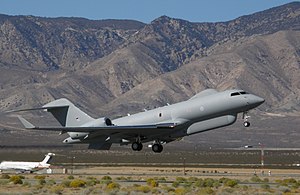No. 5 Squadron RFC
| No. 5 Squadron RAF | |
|---|---|

A Sentinel R.1 in 2007
|
|
| Active | 26 July 1913 – 1947 1949–1957 1959 – 2003 2004 – present |
| Role | Ground Reconnaissance (ASTOR) |
| Garrison/HQ | RAF Waddington |
| Motto(s) | (Latin): Frangas non flectas ("Thou mayst break, but shall not bend me") |
| Equipment | Raytheon Sentinel |
| Battle honours |
World War I: Mons, Ypres 1915, Loos, Arras, Somme 1918, Amiens World War II: Arakan 1942–1944, Burma 1944–1945 |
| Insignia | |
| Squadron badge heraldry | A maple leaf |
| Squadron roundel | |
No. 5 (Army Co-operation) Squadron often styled V(AC) Squadron of the Royal Air Force is the operator of the Sentinel R1 Airborne STand-Off Radar (ASTOR) aircraft.
As No. 5 Squadron Royal Flying Corps, it was formed at Farnborough on 26 July 1913, and following the outbreak of the First World War deployed to France on 15 August, equipped with a variety of aircraft types to implement reconnaissance for the British Expeditionary Force (BEF). It flew its first missions on 21 August and on the next day, an Avro 504 of 5 Squadron was the first British aircraft to be shot down, its crew of pilot Second Lieutenant Vincent Waterfall and navigator Lieutenant Charles George Gordon Bayly being killed over Belgium.
No. 5 Squadron standardized on the B.E.2, specializing as observers for artillery, re-equipping with the R.E.8 in May 1917, and working closely with the Canadian Corps, through to the end of the war and into 1919, when it moved into Germany as part of the Army of Occupation. (Its association with the Canadian Corps lead the incorporation of a maple leaf in the squadron's badge when it was approved in June 1937.)
Thereafter in 1920, the squadron was reformed at Quetta, India (now part of Pakistan). There it continued working in Army Air Cooperation for operations on the North West Frontier. From 1920 until 1941 they had a succession of aircraft: Bristol Fighters, Westland Wapitis, Hawker Harts and Hawker Audaxs. In 1942 they received American built Mohawks and became escorts to Blenheim bombers over north west Burma. These were replaced in turn by Hawker Hurricanes and P-47 Thunderbolts. No. 5 Squadron converted to Tempest IIs in February 1946, but disbanded on 1 August 1947.
...
Wikipedia
